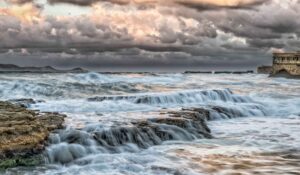FRESHWATER HABITAT
Freshwater habitat refers to aquatic habitats that are free of salt. Examples include rivers, streams, and some lakes.
Characteristics of Freshwater Habitat
- It has low salt content (low salinity) and little to no salt.
- The water body is much smaller than the marine habitat.
- It is affected by seasonal variations (i.e., rainy and dry seasons).
- The water is transparent, and light penetrates the surface.
- Temperature can vary with depth and season, affecting living organisms because they have a narrow tolerance.
- All parts of freshwater contain oxygen.
- The freshwater habitats are isolated from one another.
Types of Freshwater Habitat
There are two types:

- Standing freshwater- – This is a freshwater habitat where water does not flow but is still calm. Pools, ponds, ditches, lakes.

- Lotic/running water is flowing water, e.g., streams, rivers, and springs.
Ecological Zones In Freshwater Habitat
Four zones make up freshwater habitats.
- Top edge zone
- Top central zone
- Deeper central zone
- Bottom zone
Information about ecological zones of freshwater habitats, their characteristics, and the organisms that live there.
| Zones | Characteristics | Organism |
|
| Plants-: bamboo, raffia palm, algae, grassesToads, frogs, crabs, mosquito larva mosquito, and water snails are all examples of animals. |
| 2. Top central zone-literal zone |
Here you will find sub-merged plants, e.g., organisms known as neustons. *Home to many aquatic animals | Plants: Water lettuce, water hyacinth, and duckweedAnimals:- Water bags, tadpoles, water scorpions, hydras, kingfishers. Frogs, salamanders. |
| 3. Deeper central zone |
| The phytoplankton, or plants, e.g., diatoms blue-green algae.Animals include fish and flatworms. |
| 4. Bottom zones | Highest level of carbon (iv), oxide at a low light intensity | Rare plants Animals include fish and crabs, Mollusca, insect larvae, and Mollusca. Benthos are animals that live at the bottom. |
Adaptation of Organisms in freshwater habitat:
Plants:–
- Hydrophytes are water plants.
- For easy transpiration, they have stomata at the surface of their leaves. water lily
- For protection, some people have mucilage applied to their bodies. spirogyra
- Some people have hair between their leaves to trap air to float on water.
Animals:-
- Some animals have gills that allow them to breathe, e.g., fish and tadpoles.
- Some are equipped with sucker, hook, and stick attachments. Others have operculum to regulate the inflow from the outside.
- Some people have long legs that allow them to skate on the water’s surface, e.g., pond skaters.
- Some people have hairs and brush for a fitter feeling, e.g., mosquito larvae.
- To escape danger or avoid desiccation, some burrow into the mud.
Classification of Freshwater Organisms
- Based on the major niche and position within the food chain
- Autotrophs– (products), e.g. plant algae
- Phagotroph (macro consumer), e.g. crab fish
- Saprotrophs, e.g. (micro-consumers) and decomposed organisms that feed on dead organic matter, e.g., bacteria and fungi.
- Based on your life habits, We have
- Benthos — Bottom dwellers e.g., flatworm, mollusks
- Periphytons, e.g., Algae and insects
- Plantation e.g., algae, rotifers, cape pod
- Neukton e.g. Neukton e.g.
- Neuston- Adult insect, e.g., pond skater.
Food Chain In Freshwater Habitat
The phytoplankton is the producer of freshwater habitat, while the zooplanktons (and larger animals) are the consumers.
Phytoplanktons are –> Zoolankton is –> larger animal.
Chlorella –> Rotifers –> Tilapia

